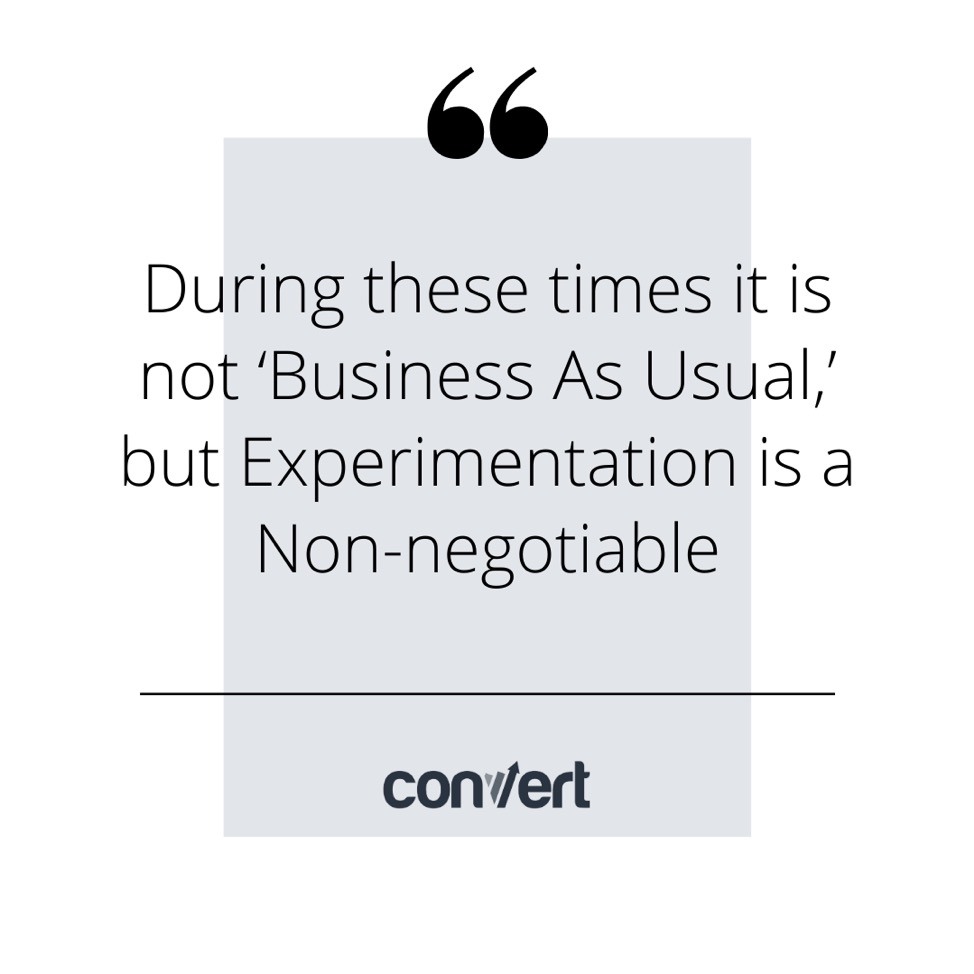Why You Need To Test More Than Ever During and After COVID-19 (And How to Make the C-Suite Agree With You)
You invested time, energy, and money into creating an optimization and testing dream team. Even if you are a team of one, your experimentation program didn’t just happen; it took dedication and maybe even a little muscle.
Things are finally running smoothly. You have buy-in from all the key stakeholders.
Then BOOM, COVID-19 strikes the world like an atomic weapon.
And just like that, everything gets turned upside down and the C-Suite asks you to justify the existence of your CRO strategy, plans, and operations.
You find your baby on the chopping block. And what you do next will determine if you get her back in one piece or not.
Even if you haven’t found yourself in this position, but don’t get surprised if the number of questions you receive escalated. Many companies are looking for ways to restructure, reduce cost, and cut flab that exists in their business.
You may be an in-house tester who reports to a manager, or a CRO agency that has to justify projects or software usage to clients.
No matter which category you fall into, this article will give you insight into how to convince your C-suite that testing is even more critical in these uncertain times.
We will explore several methods and considerations, including how to:
- Show value;
- Use case studies as proof;
- Understand the desires and current stresses of the C-Suite; and
- Handle objections.
Let’s dive in… but first, let’s set a framework…
It’s Not Personal
To be effective in this negotiation, you must understand this: it’s not personal.
In uncertain times, everything becomes questionable. The brain processes uncertainty as a dangerous threat, which translated into hypervigilant behavior.
YOU: “I would like to talk to you about our testing program”
C-SUITE Respond:
Depending on the relationship you have with the people you have to negotiate with, this conversation can be intimidating.
In an article, “Why Uncertainty Freaks You Out,” Bryan E. Robinson Ph.D. describes what happens in the brain when uncertainty exists,
When certainty is questioned, your lizard brain goes haywire, instantly kicking you in the pants in an attempt to spur you to action and get you to safety.
Google insights backup Dr. Robinson’s description. There has been a 600% increase in searches for “can you get coronavirus twice.”
People are scared, and even though business continues, the uncertainty of what COVID-19 bears lurks in the background affecting all decision-making.
Don’t underestimate the presence of your humanity. You are a professional, but when things are already chaotic and full of uncertainty, having to justify your work can feel overwhelming and like a personal attack.
To say it’s a unique time in the world is an understatement. As we all collectively grapple with what this global pandemic means for us — as humans first, but also as professionals — there are often more questions than answers.
Joshua Spanier, the VP of Google’s global marketing for media
Understanding it is not personal can help you strategize and plan without emotional baggage. This knowledge dismantles its power to influence your approach.
It also gives you insight into how others may feel, which means you can deal with them with compassion and tailor your plan to speak logically but also provide the information their reptilian brain needs to feel calm.

Things are not business as usual which means considerations are different, and the way you approach conversations about budget, resources, operations may all feel stress related to this current situation.
Change Is A Universal Constant, But That Doesn’t Make It Comfortable
Conditions, ideas, policies, resources and needs are changing at rapid speed. The only thing guaranteed in times of uncertainty is this: things can and will change.
Not a comforting thought when the tendency of most companies and people is to move in sync with status-quo, whether that be across the industry or internally.
Think of how many businesses are being thrust into new paradigms:
- Brick and Mortar stores are moving online.
- In-person training is being delivered virtually.
- Office-based teams are working remotely.
There is one thing in common with the examples above, businesses and organizations are being forced to try something new – they are experimenting. Remember this as you talk to the C-Suite.
The Truth About the Relationship between Business and Experimentation
Experimentation is not a random auxiliary program. It’s embedded into every business like the letters on a keyboard. The best businesses formalize this program for multilayered optimization. Convert’s CEO, Dennis van der Heijden puts it best,
Running a company is one Big Experiment. You never know what works and always have to keep trying to improve your product and services. In times like this where ‘The Great Lockdown’ is affecting billions of people, it feels like everything changed. But really, you are still running experiments all the time, you are just not always measuring them.
Dennis offers the following example,
If a business puts up a sign up about a product in stock or redirects people because the stores are closed, you are experimenting, just not measuring it.
You might have a significant drop in orders, but you wouldn’t know what caused it. Without a testing method, you’d probably point to the crisis or lockdown as the culprit. But if you just ran an A/B testing on the sign you might have up on the moment where people felt comfortable enough to start ordering more without the banner. You missed it.
Measured and tracked experimentation brings you certainty in uncertain times, and that is always better than experimenting without knowing if it helped or hurt your business.
Keep this in mind as you discuss the future of your company’s experimentation with decision-makers.
Here are the 4 Keys to Convincing the C-Suite Experimentation is a Must:
- Prepare,
- Elicit the help and support of others,
- Show value, ROI
- Offer Proof.
Let’s look at the first step, preparation.
KEY #1: Preparation
There’s no doubt you will enter the conversation prepared, but it’s so important I must reiterate it.
Your time is valuable, so are the members of the C-Suite. If your first go at convincing them fails, unfortunately, you may not have another chance to have that conversation. Or worse, the following conversation will focus on finding an alternative to what you want.
Think ahead. Go on the offense. What questions will they want answered? What will they consider a win? What will make their jobs easier? Layout how making testing a priority will make them look good?
Once you have your baseline presentation, practice, practice, practice. The more relaxed and confident you are with your delivery, the better the interaction will go.
Be concise
In these times, every team member is busy. Think about how much you have on your plate. Others are experiencing similar workloads.
Being concise will help you consider your words. Are you sharing data difficult to digest? Or are you providing data through stories? Do your best to speak using language and vocabulary the C-Suite will understand. Use images to paint pictures and communicate complex ideas.
Outline The Key Benefits of Testing
Benefits of Maintaining Your Testing Budget/Projects:
- You have real data that lets you know how to move forward, and positions you to know what will yield higher performance and higher revenue.
- It offers a backbone for your analytical analysis in
Robert Brill, CEO, BrillMedia.co, says
Testing is how brands get consumers’ feedback on products, creatives, platforms, messages, and offers. Turning off this testing turns off the insights machine that makes businesses smarter.
Kimberly Porter, CEO of Microcredit Summit also understands the benefit of maintaining your testing program, she states:
As a CEO, I find A/B testing even more valuable in uncertain times. However, I can understand why others may see it more as a cost they could cut. Focus on the value add it brings to the company when trying to get others on board. A/B testing allows for a better understanding of what customers prefer and respond to which can lead to increased profits and happier customers.
Which leads us to our next point…
KEY #2 Collaborate

Your team is full of knowledge and skill. There is probably someone on your team that knows every testing stat from all the experiments and tests your company ever ran. You want to collect that information and use it.
Get stories. Success stories. Did any departments get big wins from testing and experimentation? Share them. They are powerful tools of influence.
There is power in numbers, get other team members to raise their hands to support keeping measured testing.
What if you don’t have team members who can lend a hand of support?
No worries. Reach out to other professionals in your network. Testing and experimentation are used in most successful businesses.
We ask a variety of professionals to weigh in on why experimentation is critical and offer suggestions on how to speak to C-Suites and other important stakeholders. Below are their insights.
Scenario-based testing strategies and tools such as A/B testing allow us to safely experiment and collect valuable information that enables more informed decision-making. It is quickly, easily, and inexpensively to collect and evaluate “live” data on how people will respond to different campaigns and options. With this information, leaders can leverage experiment-evaluate-adopt models to continually adjust and recalibrate based on customer responses.
Alan Zucker, Project Management Essentials, LLC
It’s important to understand what kind of messaging/CTA/design and it’s positioning is more user-friendly and generates more leads. The times are changing and each week is experiencing new market dynamics [1]—[2] for organizations, it’s maybe the most crucial time in their business timeline to listen to what their audience unsaid needs and wants are to cater to them better. A/B testing would help offer value to your customers and build a relationship of trust that could go well beyond this pandemic.
Shakun Bansal, Head of Marketing Mercer | Mettl
You can try to talk to a C-level listing all the benefits of testing, but if these benefits don’t include saving money, most probably they won’t listen to you. The best way to make a C-level consider your recommendation is to talk about money — how much it would cost if a task is not done, how much they can save by doing it, especially in times of cutting costs during a crisis. Show practical cases, history of loss because of a bad – or none at all – testing. However, it’s also worth mentioning that testing is a key element for maintaining the product quality and, therefore, the relevance of it to its users. In times of recession, with so many businesses competing against each other for clients, keeping – or even improving – the quality can define if a business will survive this period or not.
Leticia Thais Mendonça – Creative Director of Pengreen Design
It’s a very unpredictable market now and no one could have expected this turn of events. When things get uncertain, only the best, most essential businesses survive. In this time, it’s crucial to keep testing so you can see how your customers behave in a critical time period. There is one major insight that you can draw — you can see if customers are leaving you and why. By analyzing your weakest points through testing, you will be able to recession-proof your business so that you can stand firm if another crisis happens.
Jane Kovalkova is the Chief Marketing Officer at Chanty
KEY #3 Show Value, Let the Numbers Speak
The bulk of your conversation should focus on the ROI of your experimentation program and the specific tools/products you are using. Here are a few questions you can ask:
- How does your software stack up against alternatives?
- Are you using your software to its full capacity?
- Can you change to your current program that will yield greater ROI? This is an impressive way to preempt objections.
Rex Freiberger, President, Superlativ and GadgetReview shared this about communicating the ROI of experimentation:
…lead with numbers. Anything you need to communicate to a C-level executive, it’s best to do so with data. Compile your previous split tests, especially those that were most successful. Analyze and curate them so the best information is put forth — you’re supporting your position, so you need solid evidence of your claims.
Daniel Burstein, Senior Director, Content and Marketing of MarketingSherpa and MECLABS Institute echoes the importance of sharing the numbers, he says:
It’s just like any other business decision. Show the ROI. However, A/B testing has a leg up over other business investments because the ROI is easier to show.
Don’t forget to show how the ROI will be negatively affected if your testing is canned. Pain is a powerful motivator. They have already invested in experimentation, remind them of the amount. Let them know they will lose that total investment if they stop experimentation.
KEY #4 Offer Proof
People are more likely to believe what you assert if you can back it up with proof.
Offer case studies. Share the success stories you gathered from colleagues. Success stories can influence even the most cynical of characters.
Reference historical cases that show how companies grow in challenging times because they stayed the course when others bailed out. They used the opposite principle simply states, “when the masses zig, you zag.” For businesses and marketers, this means when the rest of the industry is contracting, you should be looking at ways to expand. Or at minimum, maintain your current levels of testing.
Take Testing off the Chopping Block, Time to Talk to the C-Suite
Experimentation is fundamental to the health and success of all businesses. It is not an optional commodity, rather a must-have staple. Using the four keys: preparation, collaboration, sharing ROI, proof, you will have an arsenal of leverage that will show testing and experimentation is not an optional accessory, they are business must-haves.
Written By
Nyaima Smith-Taylor

Edited By
Carmen Apostu


